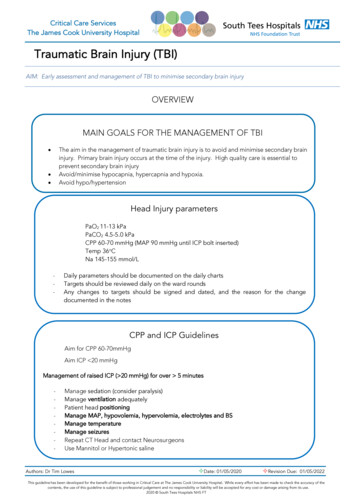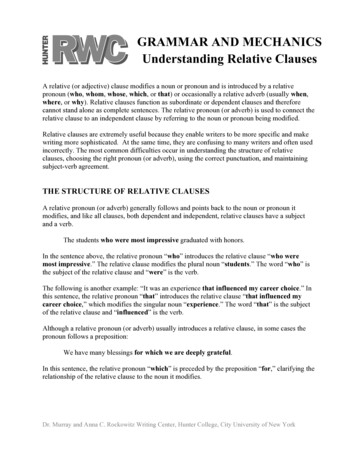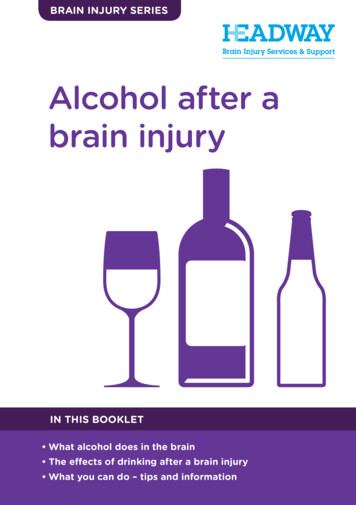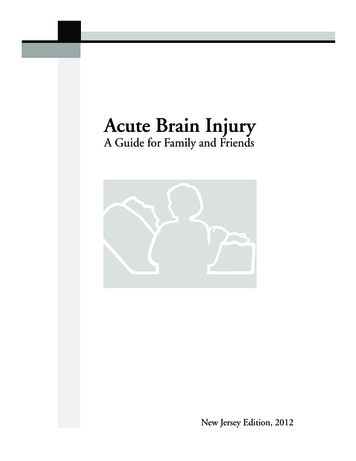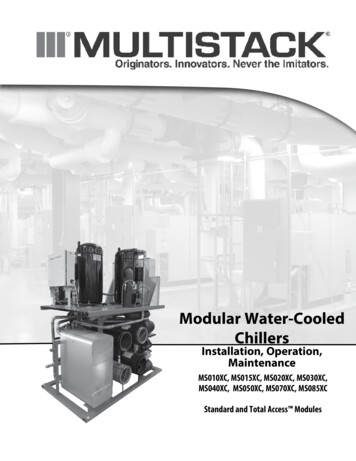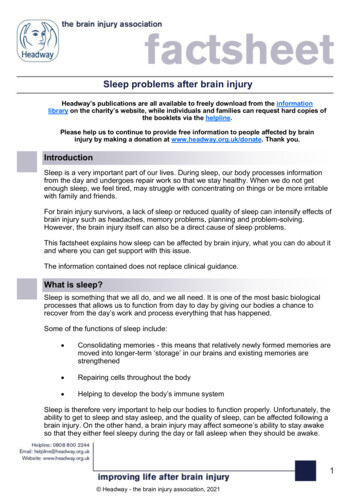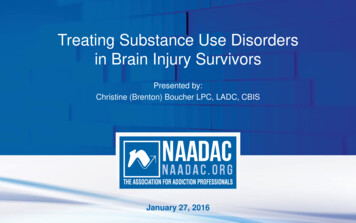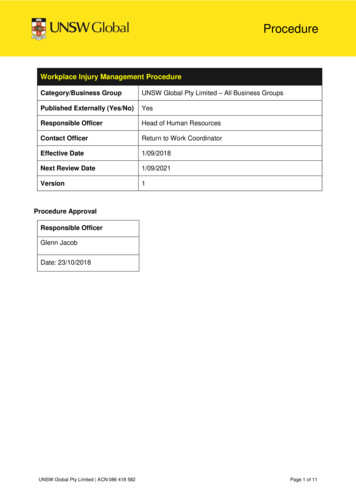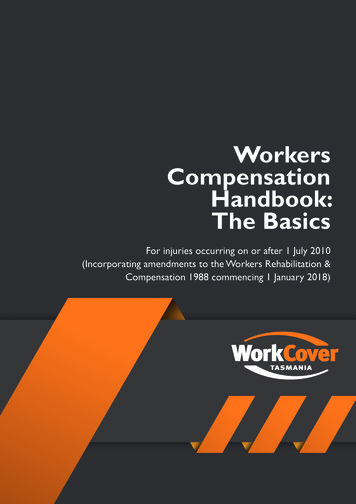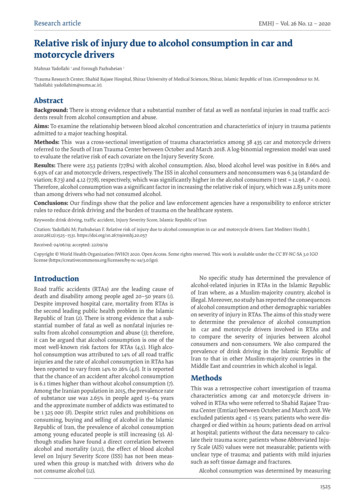
Transcription
Research articleEMHJ – Vol. 26 No. 12 – 2020Relative risk of injury due to alcohol consumption in car andmotorcycle driversMahnaz Yadollahi 1 and Forough Pazhuheian 1Trauma Research Center, Shahid Rajaee Hospital, Shiraz University of Medical Sciences, Shiraz, Islamic Republic of Iran. (Correspondence to: M.Yadollahi: yadollahim@sums.ac.ir).1AbstractBackground: There is strong evidence that a substantial number of fatal as well as nonfatal injuries in road traffic accidents result from alcohol consumption and abuse.Aims: To examine the relationship between blood alcohol concentration and characteristics of injury in trauma patientsadmitted to a major teaching hospital.Methods: This was a cross-sectional investigation of trauma characteristics among 38 435 car and motorcycle driversreferred to the South of Iran Trauma Center between October and March 2018. A log-binomial regression model was usedto evaluate the relative risk of each covariate on the Injury Severity Score.Results: There were 253 patients (7.78%) with alcohol consumption. Also, blood alcohol level was positive in 8.66% and6.93% of car and motorcycle drivers, respectively. The ISS in alcohol consumers and nonconsumers was 6.34 (standard deviation; 8.73) and 4.12 (7.78), respectively, which was significantly higher in the alcohol consumers (t test 12.96, P 0.001).Therefore, alcohol consumption was a significant factor in increasing the relative risk of injury, which was 2.83 units morethan among drivers who had not consumed alcohol.Conclusions: Our findings show that the police and law enforcement agencies have a responsibility to enforce stricterrules to reduce drink driving and the burden of trauma on the healthcare system.Keywords: drink driving, traffic accident, Injury Severity Score, Islamic Republic of IranCitation: Yadollahi M; Pazhuheian F. Relative risk of injury due to alcohol consumption in car and motorcycle drivers. East Mediterr Health J.2020;26(12):1525–1531. https://doi.org/10.26719/emhj.20.057Received: 04/06/19; accepted: 22/09/19Copyright World Health Organization (WHO) 2020. Open Access. Some rights reserved. This work is available under the CC BY-NC-SA 3.0 IGOlicense /igo).IntroductionRoad traffic accidents (RTAs) are the leading cause ofdeath and disability among people aged 20–50 years (1).Despite improved hospital care, mortality from RTAs isthe second leading public health problem in the IslamicRepublic of Iran (2). There is strong evidence that a substantial number of fatal as well as nonfatal injuries results from alcohol consumption and abuse (3); therefore,it can be argued that alcohol consumption is one of themost well-known risk factors for RTAs (4,5). High alcohol consumption was attributed to 14% of all road trafficinjuries and the rate of alcohol consumption in RTAs hasbeen reported to vary from 14% to 26% (4,6). It is reportedthat the chance of an accident after alcohol consumptionis 6.1 times higher than without alcohol consumption (7).Among the Iranian population in 2015, the prevalence rateof substance use was 2.65% in people aged 15–64 yearsand the approximate number of addicts was estimat ed tobe 1 325 000 (8). Despite strict rules and prohibitions onconsuming, buying and selling of alcohol in the IslamicRepublic of Iran, the prevalence of alcohol consumptionamong young educated people is still increasing (9). Although studies have found a direct correlation betweenalcohol and mortality (10,11), the effect of blood alcohollevel on Injury Severity Score (ISS) has not been measured when this group is matched with drivers who donot consume alcohol (12).No specific study has determined the prevalence ofalcohol-related injuries in RTAs in the Islamic Republicof Iran where, as a Muslim-majority country, alcohol isillegal. Moreover, no study has reported the consequencesof alcohol consumption and other demographic variableson severity of injury in RTAs. The aims of this study wereto determine the prevalence of alcohol consumptionin car and motorcycle drivers involved in RTAs andto compare the severity of injuries between alcoholconsumers and non-consumers. We also compared theprevalence of drink driving in the Islamic Republic ofIran to that in other Muslim-majority countries in theMiddle East and countries in which alcohol is legal.MethodsThis was a retrospective cohort investigation of traumacharacteristics among car and motorcycle drivers involved in RTAs who were referred to Shahid Rajaee Trauma Center (Emtiaz) between October and March 2018. Weexcluded patients aged 15 years; patients who were discharged or died within 24 hours; patients dead on arrivalat hospital; patients without the data necessary to calculate their trauma score; patients whose Abbreviated Injury Scale (AIS) values were not measurable; patients withunclear type of trauma; and patients with mild injuriessuch as soft tissue damage and fractures.Alcohol consumption was determined by measuring1525
Research articleEMHJ – Vol. 26 No. 12 – 2020blood alcohol level in a diagnostic laboratory. ISS wasconsidered as the outcome variable. ISS was based onradiological findings and the International StatisticalClassification of Diseases, 10th revision (ICD-10) codes.Demographic data including age, sex, type of driver,time of admission to hospital, duration of hospitalization,and ISS were studied. Experts calculated severityby referring to patients’ medical records, includingdiagnostic ICD-10 codes, surgical reports, primary triagepapers and emergency reports. Each ICD-10 injury codewas assigned to one of the 6 ISS body regions. According tothe AIS, each patient’s injured body regions correspondedto the injured body region with the highest ISS. In thisregard, all injuries received an AIS code ranging from 1(minor injury) to 6 (an injury considered incompatiblewith life). Patients with multiple injuries were scored byadding the squares of the three highest AIS scores in 3predetermined body regions. This process provided theISS which ranged from 1 to 75. Additionally, because therewas no information on alcohol consumption in patients’records, this information was based on the patients’admission code.Statistical methods such as chi2 test, two independentt tests, and one-way analysis of variance were used fordescriptive comparisons of demographic characteristicsand clinical indicators in alcohol and non-alcoholconsumers. Binary outcomes in cohort studies arecommonly analysed by applying a logistic regressionmodel to the data to obtain odds ratios (ORs) forcomparing groups with different sets of characteristics.Although this is often appropriate, there may besituations in which it is more desirable to estimate arelative risk or risk ratio (RR) instead of OR. With minormodification of the statements for logistic regression, alog-binomial model can be run to obtain the RR instead ofthe OR. All that needs to be changed is the link functionbetween the covariates and outcome (13). Therefore, a logbinomial regression model was used to evaluate the RR ofeach covariate in ISS (divided into ISS 8 vs ISS 8 basedon distribution of injury severity). A 2-sided P 0.05 wasconsidered statistically significant. Data were analysedusing Stata14 software and figures were prepared usingR 3.4.3 for Windows.This project was approved by the Research EthicsCommittee with number of IR.SUMS.REC.1397.420 byShiraz University of Medical Sciences in Shiraz, IslamicRepublic of Iran.ResultsThere were a total of 38 435 injured patients, which included 253 (7.78%) who were positive for alcohol consumption. Blood alcohol level was positive in 8.66% ofcar and 6.93% of motorcycle drivers involved in RTAs.The average age of alcohol users was 26.16 (7.98)years, 95.26% of whom were male and 4.7% female(Table 1). The ISS in alcohol users was 6.34 (8.73) andthere was a significant difference between the alcoholconsumers and nonconsumers. The number of peoplewith ISS 8 was greater among alcohol consumers thannonconsumers (26.49% vs 15.01%). The highest number ofTable 1 Comparison of demographic and clinical features (stratified by alcohol consumption)VariablesAge, mean (SD)Alcohol consumption(253)No alcohol consumption(2998)P26.16 (7.98) years33.02 (13.85) years 0.001SexMale0.045241 (95.26)2749 (91.69)12 (4.74)249 (8.31)Car139 (54.96)1467 (48.93)Motorcycle114 (45.06)1531 (51.07)FemaleType of driverInjury severity score, mean (SD)1–40.0666.34 (8.73)4.12 (7.78)156 (61.66)2371 (79.09)5–830 (11.86)177 (5.9)9–1539 (15.42)247 (8.24)16–2517 (6.72)146 (4.87) 2511 (4.35)57 (1.90)204 (80.63)1093 (36.46)Time of accident20:00–04:00 0.00104:00–12:0019 (7.51)560 (18.68)12:00–20:0030 (11.86)1345 (44.86)Injured patients per day, mean (SD) 0.001In holidays2.04 (0.34)16.31 (0.56)In non-holidays0.79 (0.07)11.55 (0.12)SD standard deviation1526 0.001
Research articleEMHJ – Vol. 26 No. 12 – 2020Table 2 Relative risk of injury based on covariatesVariablesRRZ statisticP95% CI for RRLowerUpperAge1.012.910.041.001.01Sex(Female to Male)2.164.27 0.0011.512.09Type of driver(motorcycle driver to car drivers)0.6-6.69 0.0010.650.72Alcohol2.83-44.06 0.0011.542.17CI confidence interval; RR relative risk.accidents (80.63%) among alcohol consumers occurredbetween 20:00 and 04:00 hours. The average number ofpatients injured daily was significantly greater duringholidays in comparison to working days for both alcoholconsumers and nonconsumers.A log-binomial regression model was performed todetermine the relative risk of covariates on ISS (Table2). The predictive variables were age, sex, type of driver(motorcycle or car) and alcohol consumption and theindependent variable was ISS. Increasing age with controlof other variables led to a 0.01 increase in risk of ISS in 8 patients. The risk of severe injury was significantlyhigher in motorcycle compared to car drivers. Alcoholconsumption was a significant factor in increasing therelative risk which was 2.83 units more in comparison tothat in non-alcohol consumers.A closer look at the alcohol titer among survivingpatients indicates that the severity of injury increasedwith alcohol consumption and it was higher in motorcyclethan car drivers (Figure 1).Figure 2 shows the percentage of accidents amongdrinkers in each age group. The percentage of accidentsin alcohol users was higher among younger drivers.About 12% of injured drivers aged 15–20 years had apositive result for alcohol consumption at the time of theaccident. As age increased, the number of accidents alsodecreased among alcohol users.DiscussionThe current study evaluated the effect of alcohol consumption on severity of injury in drivers involved inRTAs. The relationship between percentage of alcoholconsumption and increased risk of accident was evaluated using log-binomial regression.The prevalence of alcohol consumption while drivingwas 7.78% in our study, which is less than in other studies.The results of a study in US National Trauma DataBank (2007–2010) indicated that among a total of 88 794motorcycle drivers, 30.9% showed positive test results foralcohol (14). A study in Virginia, United States of Americashowed that prevalence of alcohol consumption whiledriving was about 36.89% (15). In Australia, blood alcoholwas present in 29.1% of all drivers (16). In a study of RTAsin Turkey, alcohol was detected in the blood of about54.4% of cases, although subjects were considered to bepositive when alcohol blood concentration exceeded50 mg/dl (17). In other studies the prevalence of alcoholin drivers was lower than in our study. A study in theUnited Arab Emirates found that the prevalence ofFigure 1 ISS stratified by blood alcohol levelMean of injury severity score10.07.97.56.54Motorcycle accident6.55Car accident5.655.04.112.812.50.0Negative alcoholISS Injury Severity Score80- 150More than 150Blood alcohol level (mg/dl)1527
Research articleEMHJ – Vol. 26 No. 12 – 2020Figure 2 Percentage of accidents among drinkers by age groupsPercentage of l consumption in car drivers was about 2.2% (18).Also, prevalence of alcohol among injured drivers wasreported as 0.45% in Norway (19). In a study in Qatar,the prevalence of driving while under the influence ofalcohol was estimated as 1.8% (20). A study in Singaporeshowed that 2.3–3.0% of fatal and injury-sustainingRTAs were alcohol related (21). The differences in alcoholconsumption patterns in different countries are due tostringent laws as well as religion. Moreover, it should benoted that our study considered blood alcohol 80 mg/dl as alcohol consumption. The permissible amount ofalcohol in the blood differs between countries; in some itis 100 mg/dl and in others it is 50 mg/dl.Our results revealed that consumption of alcoholincreased ISS by 2.8 times to 8 compared tononconsumers. Our results are consistent with thoseof Valdez et al., who showed that blood alcohol level isassociated with ISS for specific types of injuries; however,across all types of injuries, there was no significantassociation between blood alcohol level and ISS (22).We found that ISS in motorcycle drivers was higherthan that in car drivers. This is consistent with the studiesof Bolandparvaz et al., who reported injury patternsamong trauma patients of different ages and sex in theIslamic Republic of Iran (23), and Yadollahi et al., whoconducted an epidemiological study of trauma patientswho attended national, cultural and religious eventsin the Islamic Republic of Iran (24). Both those studiesincluded RTAs and showed that injury in motorcycledrivers was more severe than in car drivers. Our studywas the first to evaluate the risk of accidents causedby alcohol consumption in Fars Province. The highestprevalence of alcohol consumption among victims ofRTAs occurred in those aged 20–25 years and it seemedthat high-risk behaviour such as alcohol consumptiondecreased with advancing age. As we indicated, ISS wasin direct correlation with blood alcohol titre. Our studyshowed that the percentage of accidents among youngdrinkers was higher than among older patients, which152831-3536-40Age group41-4546-50More than 50is consistent with a study of alcohol consumption inDenmark (25).A log-binomial regression model was used in this studyto analyse injury severity due to alcohol consumption inRTAs, with control of other variables. Hoong et al. haveused this model to evaluate occurrence of RTAs at roadintersections for several years and have shown thatthe log-binomial model is more effective than survivalmodels for evaluation of relative risk of injury (26). Ourstudy can pave the way for developing theories about thereasons behind the high incidence of RTAs due to alcoholconsumption in holidays. As a result of higher injuryseverity among alcohol consumers, we recommend thatgreater supervision is needed regarding high-risk drivingbehaviour. We also advise law enforcers to implementstricter laws concerning the ban on alcohol consumption.The limitations of our study include the fact thatwe were not able to determine the type of body injuriescompared to injury severity in different parts of thebody. Moreover, data about deaths at the scene as wellas prehosital deaths, type of car, speed, seat belt use anddrowsy driving were not available. The effect of thesevaribles as well as opioid substances should be evaluatedin future studies for evaluation of competitive risksrelated to alcohol consumption in occurrence of RTAs.ConclusionTrauma is harmful to patients, imposes a burden on thehealthcare system, and is of significant concern to public health. The findings of our study show that the policeand law enforcement agencies have a responsibility to arrange preventive laws to reduce the overall prevalence ofdrink driving and decrease the burden of trauma on thehealthcare system.Funding: This research was supported with grant number of 97-01-38-16888 by Shiraz University of MedicalSciences in Shiraz, Islamic Republic of Iran.Competing interests: None declared.
Research articleEMHJ – Vol. 26 No. 12 – 2020Risque relatif de traumatismes dus à la consommation d'alcool chez les conducteursde voitures et de motosRésuméContexte : Il existe des preuves solides indiquant qu'un nombre important de traumatismes, mortels et non mortels, dansles accidents de la circulation résultent de la consommation et de l'abus d'alcool.Objectifs : Examiner la relation entre le taux d'alcoolémie et les caractéristiques des blessures chez les patients traumatisésadmis dans un grand hôpital universitaire.Méthodes : Il s'agissait d'une étude transversale des caractéristiques des traumatismes chez 38 435 conducteurs devoitures et de motos envoyés au Centre de traumatologie du sud de la République islamique d’Iran entre octobre etmars 2018. Un modèle de régression log-binomial a été utilisé pour évaluer le risque relatif de chaque covariable enutilisant le Score de gravité des traumatismes.Résultats : 253 patients (7,78 %) avaient une consommation d’alcool. En outre, le taux d'alcoolémie était positif chez8,66 % et 6,93 % des conducteurs de voitures et de motos, respectivement. Le Score de gravité des traumatismes chez lesconsommateurs d'alcool et les non-consommateurs était de 6,34 (écart-type ; 8,73) et 4,12 (7,78), respectivement, ce quiétait significativement plus élevé chez les consommateurs d'alcool (test t 12,96, p 0,001). La consommation d'alcool estdonc un facteur important dans l'augmentation du risque relatif de blessure, qui est de 2,83 unités de plus que chez lesconducteurs qui n'ont pas consommé d'alcool.Conclusions : Nos conclusions montrent que la police et les forces de l'ordre ont la responsabilité d'appliquer des règlesplus strictes pour réduire la conduite sous l’emprise de l’alcool et le fardeau des traumatismes qui pèsent sur le systèmede soins de santé. لتعرض سائقي الدراجات النارية والسيارات لإلصابات بسبب تعاطي الكحول ُّ اخلطر النسبي فروغ بجوهیان ، مهناز یداهلل اخلالصة َث َّمة دالئل قوية عىل أن عدد ًا كبري ًا من اإلصابات املميتة وغري املميتة املرتبطة بحوادث املرور عىل الطرق نامجة عن تعاطي الكحول وإساءة : اخللفية . استخدامه هدفت هذه الدراسة إىل دراسة العالقة بني تركيز الكحول يف الدم وخصائص اإلصابة لدى مرىض اإلصابات الشديدة الذين ُأدخلوا إىل : األهداف . مستشفى تعليمي رئييس سائق سيارة ودراجة نارية ُأحيلوا إىل مركز جنوب إيران 38435 ُأجري هذا االستقصاء املقطعي خلصائص اإلصابات الشديدة لدى : طرق البحث واستُخدم نموذج انحدار لوجستي ذو حدين لتقييم اخلطر النسبي .2018 آذار / ترشين األول ومارس / لإلصابات الشديدة يف الفرتة بني أكتوبر . لكل متغري مشرتك عىل درجة وخامة اإلصابة من سائقي السيارات 6.93% و 8.66% وكان مستوى الكحول يف الدم إجيابي ًا لدى . ) يتعاطون الكحول 7.78%( مريض ًا 253 كان هناك : النتائج )8.73 ، (االنحراف املعياري 6.34 وبلغت درجة شدة اإلصابة لدى األشخاص املتعاطني للكحول وغري املتعاطني . والدراجات النارية عىل التوايل كان تعاطي ، ولذا .)0.001 القيمة االحتاملية ،12.96 " وهي أعىل بكثري لدى املتعاطني للكحول (اختبار "يت ، ) عىل التوايل 7.78( 4.12 و ً الكحول عام وحدة مقارن ًة بالسائقني الذين مل 2.83 والذي زاد لدى السائقني املتعاطني للكحول بواقع ، ال مه ًام يف زيادة اخلطر النسبي لإلصابة . يتعاطوا الكحول ِّ ت : االستنتاجات توصلنا إليها أن الرشطة ووكاالت إنفاذ القانون تتحمل مسؤولية إنفاذ قواعد أكثر رصامة للحد من القيادة حتت َّ ُبي النتائج التي . وخفض عبء اإلصابات الشديدة الذي ينوء به نظام الرعاية الصحية ، تأثري تعاطي الكحول 1529
Research articleEMHJ – Vol. 26 No. 12 – 2020References1.Yadollahi M, Ghiassee A, Anvar M, Ghaem H, Farahmand M. Analysis of Shahid Rajaee hospital administrative data on injuriesresulting from car accidents in Shiraz, Iran: 2011–2014 data. Chin J Traumatol. 2017 Feb;20(1):27–33. http://dx.doi.org/ 10.1016/j.cjtee.2015.10.006 PMID:282337282.Montazeri A. Road-traffic-related mortality in Iran: a descriptive study. Public Health. 2004 Mar;118(2):110-3. http://dx.doi.org/10.1016/S0033-3506(03)00173-2 PMID:150370403.Daeppen JB, Gaume J, Bady P, Yersin B, Calmes JM, Givel JC, et al. Brief alcohol intervention and alcohol assessment do not influence alcohol use in injured patients treated in the emergency department: a randomized controlled clinical trial. Addiction. 2007Aug;102(8):1224–33. http://dx.doi.org/10.1111/j.1360-0443.2007.01869.x PMID:175655634.Borges G, Monteiro M, Cherpitel CJ, Orozco R, Ye Y, Poznyak V, et al. Alcohol and road traffic injuries in Latin America andthe Caribbean: a case‐crossover study. Alcoholism Clin Exp Res. 2017 Oct;41(10):1731–7. .Osman OT, Abbas AK, Eid HO, Salem MO, Abu-Zidan FM. Alcohol-related road traffic injuries in Al-Ain City, United Arab Emirates. Traffic Inj Prev. 2015;16(1):1–4. http://dx.doi.org/10.1080/15389588.2014.895923 PMID:246175826.Odero W. Alcohol-related road traffic injuries in Eldoret, Kenya. East Afr Med J. 1998 Dec;75(12):708–11. PMID:100652117.Movig KL, Mathijssen M, Nagel P, Van Egmond T, De Gier JJ, Leufkens H, et al. Psychoactive substance use and the risk of motorvehicle accidents. Accid Anal Prev. 2004 Jul;36(4):631–6. http://dx.doi.org/10.1016/S0001-4575(03)00084-8 PMID:150944178.Heydarabadi AB, Ramezankhani A, Barekati H, Vejdani M, Shariatinejad K, Panahi R, et al. Prevalence of substance abuse amongdormitory students of Shahid Beheshti University of Medical Sciences, Tehran, Iran. International journal of high risk behaviors& addiction. 2015 Jun 20;4(2):e22350. http://dx.doi.org/ 10.5812/ijhrba.22350v2 PMID:264056799.Nasrollahzadeh D, Kamangar F, Aghcheli K, Sotoudeh M, Islami F, Abnet C, et al. Opium, tobacco, and alcohol use in relation tooesophageal squamous cell carcinoma in a high-risk area of Iran. British journal of cancer. 2008 Jun 3;98(11):1857–63. http://dx.doi.org/10.1038/sj.bjc.6604369 PMID:1847530310.Gururaj G, Uthkarsh PS, Rao GN, Jayaram AN, Panduranganath V. Burden, pattern and outcomes of road traffic injuries in arural district of India. Int J Inj Contr Saf Promot. 2016;23(1):64-71. http://dx.doi.org/10.1080/17457300.2014.945465 PMID:2510962211.Global status report on alcohol and health 2018. Geneva: World Health Organization; 2018 lobal alcohol report/en/, accessed 11 May 2020).12.Esser MB, Wadhwaniya S, Gupta S, Tetali S, Gururaj G, Stevens KA, et al. Characteristics associated with alcohol consumptionamong emergency department patients presenting with road traffic injuries in Hyderabad, India. Injury. 2016 ry.2015.07.022 PMID:2626062313.Agresti A, Kateri M. Categorical data analysis. Springer; 2011.14.Ahmed N, Greenberg P. Assessing the impact of blood alcohol concentration on the rate of in-hospital mortality following traumatic motor vehicle crash injury: a matched analysis of the National Trauma Data Bank. Injury. 2019 Jan;50(1):33–8. http://dx.doi.org/10.1016/j.injury.2018.09.022 PMID:3024528015.Beydoun H, Teel A, Crowder C, Khanal S, Lo BM. Past blood alcohol concentration and injury in trauma center: propensity scoring. Journal of emergency medicine. 2014 Oct;47(4):387–94. http://dx.doi.org/10.1016/j.jemermed.2014.06.024 PMID:2516109516.Drummer OH, Gerostamoulos J, Batziris H, Chu M, Caplehorn JR, Robertson MD, et al. The incidence of drugs in drivers killedin Australian road traffic crashes. Forensic Sci Int. 2003 Jul 8;134(2–3):154–62. D:1285041117.Akgür SA, Ertas H, Altntoprak AE, Ozkan M, Kitapcoglu G. Prevalence of alcohol in blood samples from traffic accident cases inTurkey. Am J Forensic Med Pathol. 2011 Jun;32(2):136–9. http://dx.doi.org/10.1097/PAF.0b013e3182186f07 PMID:2149049618.Moazen B, Shokoohi M, Noori A, Rahimzadeh S, Saeedi Moghaddam S, Rezaei F, et al. Burden of drug and alcohol use disordersin Iran: findings from the Global Burden of Disease Study 2010. Arch Iran Med. 2015 Aug;18(8):480–5. http://dx.doi.org/015188/AIM.004 PMID:2626551519.Gjerde H, Normann PT, Pettersen BS, Assum T, Aldrin M, Johansen U, et al. Prevalence of alcohol and drugs among Norwegianmotor vehicle drivers: a roadside survey. Accid Anal Prev. 2008 Sep;40(5):1765–72. 76010620.Eid AM. Road traffic accidents in Qatar. The size of the problem. Accid Anal Prev. 1980 Dec;12(4):287–98. o TC, Lo D, Bloodworth BC, Tan-Siew W. Drinking and driving in Singapore, 1987 to 1989. Arukoru Kenkyuto Yakubutsu Ison.1992 Feb;27(1):30–41. PMID:159624222.Valdez C, Radomski M, Renne C, Amdur R, Dunne J, Sarani B. Alcohol level and injury severity: is the floppy patient myth true? JSurg Res. 2016;200(2):664–8. http://dx.doi.org/10.1016/j.jss.2015.10.001 PMID:2652167623.Bolandparvaz S, Yadollahi M, Abbasi HR, Anvar M. Injury patterns among various age and gender groups of trauma patientsin southern Iran: a cross-sectional study. Medicine. 2017 Oct;96(41):e7812. 290198741530
Research articleEMHJ – Vol. 26 No. 12 – 202024.Yadollahi M, Gerami M, Shamsedini N. Epidemiologic Study of Trauma Patients Admitted to Shahid Rajaee Hospital of Shiraz,Iran on National, Religious, and Cultural Occasions within 2009-2014. J Health Res Commun. 2017;3(1):38–44. monsen KW, Linnet K, Rasmussen BS. Driving under the influence of alcohol and drugs in the eastern part of Denmark in 2015and 2016: abuse patterns and trends. Traffic injury prevention. 2018 Jun 4;19(5):468–75. http://dx.doi.org/10.1080/15389588.2018.1428743 PMID:2937054326.Chin HC, Quddus MA. Applying the random effect negative binomial model to examine traffic accident occurrence at signalizedintersections. Accid Anal Prev. 2003 Mar;35(2):253–9. http://dx.doi.org/10.1016/s0001-4575(02)00003-9 PMID:125041461531
About 12% of injured drivers aged 15-20 years had a positive result for alcohol consumption at the time of the accident. As age increased, the number of accidents also decreased among alcohol users. Discussion The current study evaluated the effect of alcohol con-sumption on severity of injury in drivers involved in RTAs.
